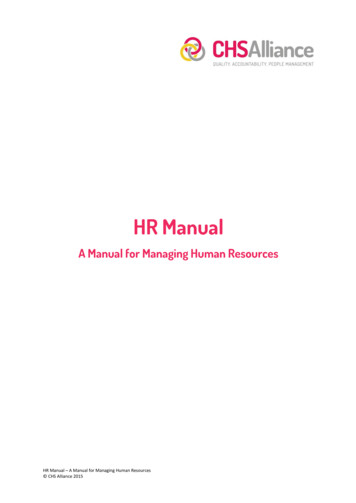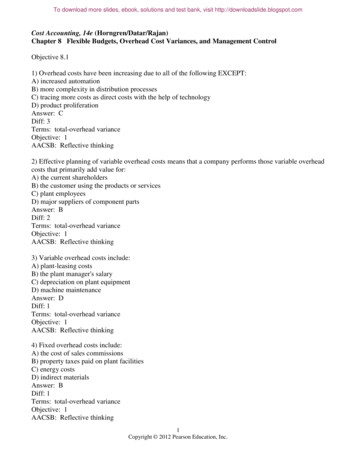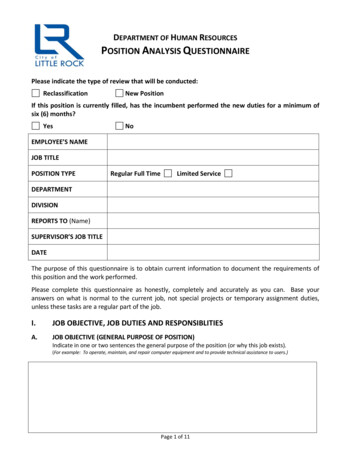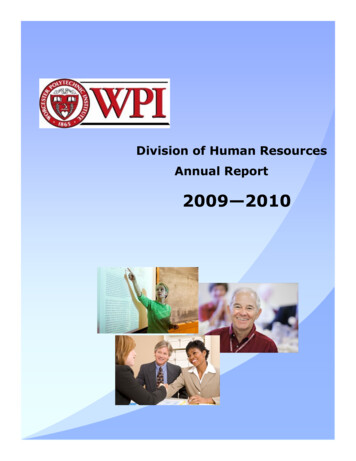
Transcription
BILL VARIE/CORBISManaging Human Resources, 14e, Bohlander/Snell - 2007 Thomson South-Western
chapter8Appraising and ImprovingPerformance3Describe the different sourcesperformance appraisalsand the reasons they cansometimes fail.an effective appraisal program.objectiveobjective2Identify the characteristics ofExplain the purposes of4Explain the various methodsobjectiveobjective1objectiveAfter studying this chapter, you should be able to5Outline the characteristics of anused for performance evaluation.effective performance appraisalinterview.of appraisal information.PART 3Developing Effectiveness in Human ResourcesManaging Human Resources, 14e, Bohlander/Snell - 2007 Thomson South-Western347
348PART 3Developing Effectiveness in Human Resourcesn the preceding chapters, we have discussed some of the most effectivemethods available to managers for acquiring and developing top-notchemployees. But talented employees are not enough—successful organizations are particularly adept at engaging their workforce to achievegoals that benefit the organization as well as the individuals.In this chapter we turn to performance appraisal programs, which areamong the most helpful tools an organization can use to maintain andenhance productivity and facilitate progress toward strategic goals. While wewill focus mainly on formal performance appraisal procedures, the processesof managing and evaluating performance can be informal as well. All managers monitor the way employees work and assess how this matches organizational needs. They form impressions about the relative value of employeesto the organization and seek to maximize the contribution of every individual.Yet while these ongoing informal processes are vitally important, most organizations also have a formal performance appraisal once or twice a year. Infact, in a survey of employees conducted by Mercer Human Resources Consulting, only a third of the 2,600 respondents had received a formal performance appraisal in the past year, and only 26 percent receive regular coachingfrom their manager on improving performance. Of those who said they’d hada formal performance appraisal in the past twelve months, 62 percentexpressed a strong sense of commitment to their organization, compared to49 percent of employees who hadn’t.1The success or failure of a performance appraisal program depends onthe philosophy underlying it, its connection with business goals, and the attitudes and skills of those responsible for its administration. Many differentmethods can be used to gather information about employee performance.However, gathering information is only one step in the appraisal process. Theinformation must be evaluated in the context of organizational needs and communicated to employees so that it will result in high levels of performance.IPerformance Appraisal Programsperformance appraisalA process, typically performed annually by asupervisor for a subordinate, designed to helpemployees understandtheir roles, objectives,expectations, and performance successperformancemanagementThe process of creating awork environment in whichpeople can perform tothe best of their abilitiesThe performance appraisal can be defined as a process, typically delivered annuallyby a supervisor to a subordinate, designed to help employees understand their roles,objectives, expectations and performance success. Performance management is theprocess of creating a work environment in which people can perform to the best oftheir abilities. It is a whole work system that begins when a job is defined. Formalprograms for performance appraisal and merit ratings are by no means new toorganizations. The federal government began evaluating employees in 1842, whenCongress passed a law mandating yearly performance reviews for department clerks.From this early beginning, performance appraisal programs have spread to large andsmall organizations in both the public and private sectors. Advocates see these HRprograms as among the most logical means to appraise, develop, and effectively utilize the knowledge and abilities of employees. However, a growing number ofobservers point out that performance appraisals frequently fall short of their potential. In an ongoing survey of employee attitudes by the HR consulting firm WatsonWyatt, only 30 percent of employees said they thought their company’s performanceManaging Human Resources, 14e, Bohlander/Snell - 2007 Thomson South-Western
CHAPTER 8Appraising and Improving Performance349objectivemanagement process actually improved employee performance; only one in fivethought it helped poorly performing employees do better.2The push toward teamwork, continuous improvement, learning, and the like hascaused numerous organizations to rethink their approach to appraisal. Some arguethat performance appraisal discourages teamwork because it frequently focuses onindividual achievement and produces a self-focus rather than a team focus. Otherscontend that appraisals are useful only at the extremes—highly effective or highlyineffective employees—and are not as useful for the majority of employees in themiddle. Others point out that appraisals may focus on short-term achievementsrather than long-term improvement and learning. They are sometimes too subjectiveor inconsistent or autocratic in that they create a distance between manager andemployee rather than creating a team environment. Companies such as Xerox,Motorola, and Procter & Gamble have modified their performance appraisals to better acknowledge the importance of teamwork, continuous improvement, quality, andthe like. Each of these issues is discussed at greater length throughout the chapter.3Purposes of Performance Appraisal1It might seem at first glance that performance appraisals are used for a rather narrowpurpose—to evaluate who is doing a good job (or not). But in reality performanceappraisals are one of the most versatile tools available to managers. They can servemany purposes that benefit both the organization and the employee whose performance is being appraised.Figure 8.1 shows the most common uses of performance appraisals. In general,these can be classified as either administrative or developmental.Administrative PurposesFrom the standpoint of administration, appraisal programs provide input that can beused for the entire range of HRM activities. For example, research has shown thatFigure 8.1Purposes for Performance AppraisalDEVELOPMENTALProvide performance feedbackIdentify individual strengths/weaknessesRecognize individual performanceAssist in goal identificationEvaluate goal achievementIdentify individual training needsDetermine organizational training needsReinforce authority structureAllow employees to discuss concernsImprove communicationProvide a forum for leaders to helpADMINISTRATIVEDocument personnel decisionsDetermine promotion candidatesDetermine transfers and assignmentsIdentify poor performanceDecide retention or terminationDecide on layoffsValidate selection criteriaMeet legal requirementsEvaluate training programs/progressPersonnel planningMake reward/compensation decisionsManaging Human Resources, 14e, Bohlander/Snell - 2007 Thomson South-Western
350PART 3Developing Effectiveness in Human Resourcesperformance appraisals are used most widely as a basis for compensation decisions.4The practice of “pay-for-performance” is found in all types of organizations. Performance appraisal is also directly related to a number of other major HR functions,such as promotion, transfer, and layoff decisions. Performance appraisal data may alsobe used in HR planning, in determining the relative worth of jobs under a job evaluation program, and as criteria for validating selection tests. Performance appraisals alsoprovide a “paper trail” for documenting HRM actions that may result in legal action.Because of government EEO/AA directives, employers must maintain accurate, objective records of employee performance in order to defend themselves against possiblecharges of discrimination in connection with such HRM actions as promotion, salarydetermination, and termination. Finally, it is important to recognize that the successof the entire HR program depends on knowing how the performance of employeescompares with the goals established for them. This knowledge is best derived from acarefully planned and administered HR appraisal program. Appraisal systems have thecapability to influence employee behavior, thereby leading directly to improved organizational performance.5Developmental PurposesFrom the standpoint of individual development, appraisal provides the feedbackessential for discussing strengths and weaknesses as well as improving performance.Regardless of the employee’s level of performance, the appraisal process provides anopportunity to identify issues for discussion, eliminate any potential problems, andset new goals for achieving high performance. Newer approaches to performanceappraisal emphasize training as well as development and growth plans for employees.A developmental approach to appraisal recognizes that the purpose of a manager is toimprove job behavior, not simply to evaluate past performance. Having a sound basisfor improving performance is one of the major benefits of an appraisal program.Companies such as Best Buy and EDS have redesigned their performanceappraisal systems to focus more on employee development and learning. EDS, forexample, integrated its performance appraisal system to work in concert with learning and career management objectives. The new system, called the Career ResourceSystem, includes a detailed job description, a performance review, and a career planner to track long-term goals, as well as access to the company’s automated careerlibrary. The system is ultimately linked to the company’s succession policies. By creating this overall system, EDS hopes to shift the role of manager from that of “judge”to one of “coach.”6Reasons Appraisal Programs Sometimes FailIn actual practice, and for a number of reasons, formal performance appraisal programs sometimes yield disappointing results. Figure 8.2 shows that the primary culprits include lack of top-management information and support, unclear performancestandards, rater bias, too many forms to complete, and use of the program for conflicting purposes. For example, if an appraisal program is used to provide a writtenappraisal for salary action and at the same time to motivate employees to improvetheir work, the administrative and developmental purposes may be in conflict. As aresult, the appraisal interview may become a discussion about salary in which themanager seeks to justify the action taken. In such cases, the discussion might have little influence on the employee’s future job performance.Managing Human Resources, 14e, Bohlander/Snell - 2007 Thomson South-Western
CHAPTER 8Appraising and Improving PerformanceFigure 8.2351Let Me Count the Ways . . .There are many reasons why performance appraisal systems might not beeffective. Some of the most common problems include the following: Inadequate preparation on the part of the manager. Employee is not given clear objectives at the beginning of performanceperiod. Manager may not be able to observe performance or have all the information. Performance standards may not be clear. Inconsistency in ratings among supervisors or other raters. Rating personality rather than performance. The halo effect, contrast effect, or some other perceptual bias. Inappropriate time span (either too short or too long). Overemphasis on uncharacteristic performance. Inflated ratings because managers do not want to deal with “bad news.” Subjective or vague language in written appraisals. Organizational politics or personal relationships cloud judgments. No thorough discussion of causes of performance problems. Manager may not be trained at evaluation or giving feedback. No follow-up and coaching after the evaluation.Sources: Patricia Evres, “Problems to Avoid during Performance Evaluations,” Air Conditioning,Heating & Refrigeration News 216, no. 16 (August 19, 2002): 24–26; Clinton Longnecker andDennis Gioia, “The Politics of Executive Appraisals,” Journal of Compensation and Benefits 10,no. 2 (1994): 5–11; “Seven Deadly Sins of Performance Appraisals,” Supervisory Management 39,no. 1 (1994): 7–8.As with all HR functions, if the support of top management is lacking, theappraisal program will not be successful. Even the best-conceived program will notwork in an environment where appraisers are not encouraged by their superiors totake the program seriously. To underscore the importance of this responsibility, topmanagement should announce that effectiveness in appraising subordinates is a standard by which the appraisers themselves will be evaluated.Other reasons performance appraisal programs can fail to yield the desiredresults include the following:1.2.3.4.5.There is little face-to-face discussion between the manager and the employeebeing appraised.The relationship between the employee’s job description and the criteria on theappraisal form isn’t clear.Managers feel that little or no benefit will be derived from the time and energyspent in the process, or they are concerned only with bad performances.Managers dislike the face-to-face confrontation of appraisal interviews.Managers are not sufficiently adept at rating employees or providing them withappraisal feedback.Managing Human Resources, 14e, Bohlander/Snell - 2007 Thomson South-Western
352PART 36.7.Developing Effectiveness in Human ResourcesThe judgmental role of appraisal conflicts with the helping role of developingemployees.The appraisal is just a once-a-year event, and there is little follow-up afterward.In many organizations, performance appraisals are conducted only once ayear—but that is changing. More organizations are beginning to conduct them on asemiannual basis, and even quarterly. An important principle of performanceappraisal is that continual feedback and employee coaching must be a positive dailyactivity. The annual or semiannual performance review should simply be a logicalextension of the day-to-day supervision process.One of the main concerns of employees is the fairness of the performanceappraisal system, as the process is central to so many HRM decisions. Employeeswho believe the system is unfair may consider the appraisal interview a waste of timeand leave the interview with feelings of anxiety or frustration. Also, they may viewcompliance with the appraisal system as perfunctory and thus play only a passiverole during the interview process. By addressing these employee concerns during theplanning stage of the appraisal process, the organization will help the appraisal program succeed in reaching its goals.7Finally, organizational politics can introduce a bias even in fairly administeredemployee appraisals.8 For example, managers may inflate evaluations because theydesire higher salaries for their employees or because higher subordinate ratings makethem look good as managers. Alternatively, managers may want to get rid of troublesome employees, passing them off to another department by inflating their ratings.objectiveDeveloping an Effective Appraisal Program2The HR department ordinarily has the primary responsibility for overseeing and coordinating the appraisal program. Managers from the operating departments must alsobe actively involved, particularly in helping to establish the objectives for the program.Furthermore, employees are more likely to accept and be satisfied with the performance appraisal program when they have the chance to participate in its development.Their concerns about fairness and accuracy in determining raises, promotions, andthe like tend to be alleviated somewhat when they have been involved at the planningstage and have helped develop the performance standards themselves.What Are the Performance Standards?Before any appraisal is conducted, the standards by which performance is to be evaluated should be clearly defined and communicated to the employee. As discussed inChapter 4, these standards should be based on job-related requirements derivedfrom job analysis and reflected in an employee’s job description and job specifications. When performance standards are properly established, they help translateorganizational goals and objectives into job requirements that convey acceptable andunacceptable levels of performance to employees.As shown in Figure 8.3, there are four basic considerations in establishing performance standards: strategic relevance, criterion deficiency, criterion contamination, and reliability.Managing Human Resources, 14e, Bohlander/Snell - 2007 Thomson South-Western
CHAPTER 8Figure 8.3353Appraising and Improving PerformanceEstablishing Performance StandardsCriterion contamination:Elements that affect theappraisal measures thatare not part of the actualperformanceStrategic relevance:Performance standardslinked to organizationalgoals and competenciesPerformance measuresZone of validassessmentActual performanceReliability: Measures thatare consistent acrossraters and over timeCriterion deficiency: Aspects of actualperformance that are not measuredStrategic RelevanceStrategic relevance refers to the extent to which standards relate to the strategicobjectives of the organization. For example, if an organization has established a standard that “95 percent of all customer complaints are to be resolved in one day,” thenit is relevant for the customer service representatives to use such a standard for theirevaluations. Companies such as 3M and Buckman Laboratories have strategic objectives that 25–30 percent of their sales are to be generated from products developedwithin the past five years. These objectives are translated into performance standardsfor their employees. General Motors and Whirlpool include other objectives such ascost, quality, and speed. They develop metrics to identify and compare their performance around the world on these measures.9Criterion DeficiencyA second consideration in establishing performance standards is the extent to whichthe standards capture the entire range of an employee’s responsibilities. When performance standards focus on a single criterion (such as sales revenues) to the exclusionof other important but less quantifiable performance dimensions (such as customerservice), then the appraisal system is said to suffer from criterion deficiency.10Criterion ContaminationJust as performance criteria can be deficient, they can also be contaminated. Thereare factors outside an employee’s control that can influence his or her performance.A comparison of performance of production workers, for example, should not becontaminated by the fact that some have newer machines than others do. A comparison of the performance of traveling salespeople should not be contaminated by thefact that territories differ in sales potential.11Managing Human Resources, 14e, Bohlander/Snell - 2007 Thomson South-Western
354PART 3Developing Effectiveness in Human ResourcesReliabilityAs discussed in Chapter 6, reliability refers to the stability or consistency of a standard, or the extent to which individuals tend to maintain a certain level of performance over time. In ratings, reliability may be measured by correlating two sets of ratings made by a single rater or by two different raters. For example, two managersmay rate the same individual and estimate his or her suitability for a promotion.Their ratings could be compared to determine interrater reliability.Performance standards permit managers to specify and communicate preciseinformation to employees regarding quality and quantity of output. Therefore, whenperformance standards are written, they should be defined in quantifiable and measurable terms. For example, “ability and willingness to handle customer orders” is notas good a performance standard as “all customer orders will be filled in four hourswith a 98 percent accuracy rate.” When standards are expressed in specific, measurable terms, comparing the employee’s performance against the standard results in amore justifiable appraisal.Are You Complying with the Law?Because performance appraisals are used as one basis for HRM actions, they mustmeet certain legal requirements. In Brito v Zia, for example, the Supreme Courtruled that performance appraisals were subject to the same validity criteria as selection procedures.12 As the courts have made clear, a central issue is to have carefullydefined and measurable performance standards. In one landmark case involving testvalidation, Albemarle Paper Company v Moody (discussed in Chapter 3), the U.S.Supreme Court found that employees had been ranked against a vague standard,open to each supervisor’s own interpretation. The Court stated that “there is no wayof knowing precisely what criteria of job performance the supervisors were considering, whether each supervisor was considering the same criteria, or whether, indeed, COMSTOCK IMAGES/GETTY IMAGESSpecific, measurable jobstandards help removevagueness and subjectivity from performanceappraisals.Managing Human Resources, 14e, Bohlander/Snell - 2007 Thomson South-Western
CHAPTER 8Appraising and Improving Performance355any of the supervisors actually applied a focused and stable body of criteria of anykind.”13 This decision has prompted organizations to try to eliminate vagueness indescriptions of traits such as attitude, cooperation, dependability, initiative, and leadership. For example, the trait “dependability” can be made much less vague if it isspelled out in terms of employee tardiness and/or unexcused absences. In general,reducing room for subjective judgments will improve the entire appraisal process.Furthermore, other court decisions show that employers might face legal challenges to their appraisal systems when appraisals indicate acceptable or above-averageperformance but employees are later passed over for promotion, disciplined for poorperformance, discharged, or laid off from the organization. In these cases, the performance appraisals can undermine the legitimacy of the subsequent personnel decision. Intel, for example, was recently taken to court by a group of former employeeson grounds that the performance appraisal system (used for layoff decisions) wasunreliable and invalid. Other companies such as Goodyear and Ford have also facedlegal battles because their performance appraisals were viewed as discriminatoryagainst older workers.14 In light of court cases such as these, performance appraisalsshould meet the following legal guidelines:Performance ratings must be job-related, with performance standards developedthrough job analysis.Employees must be given a written copy of their job standards in advance ofappraisals.Managers who conduct the appraisal must be able to observe the behavior theyare rating. This implies having a measurable standard with which to compareemployee behavior.Supervisors should be trained to use the appraisal form correctly. They shouldbe instructed in how to apply appraisal standards when making judgments.Appraisals should be discussed openly with employees and counseling or corrective guidance offered to help poor performers improve their performance.An appeals procedure should be established to enable employees to expressdisagreement with the appraisal.15objectiveTo comply with the legal requirements of performance appraisals, employersmust ensure that managers and supervisors document appraisals and reasons forsubsequent HRM actions. This information may prove decisive should an employeetake legal action. An employer’s credibility is strengthened when it can support performance appraisal ratings by documenting instances of poor performance.3Who Should Appraise Performance?Just as there are multiple standards by which to evaluate performance, there are alsomultiple candidates for appraising performance. Given the complexity of today’sjobs, it is often unrealistic to presume that one person can fully observe and evaluatean employee’s performance. At IBM, employees with high potential are regularlyreviewed by a broad cross-section of the company’s leaders, not just their immediatebosses. As shown in Figure 8.4, raters may include supervisors, peers, team members,self, subordinates, customers, vendors, and suppliers. And each may be more or lessuseful for the administrative and developmental purposes we discussed earlier. Companies such as Cigna, Black & Decker, and Disney have used a multiple-raterManaging Human Resources, 14e, Bohlander/Snell - 2007 Thomson South-Western
356PART 3Developing Effectiveness in Human ResourcesFigure 8.4Alternative Sources of AppraisalSuperiorPeme TemserambersersVendorsSuppliersmSelfSubordin atesCustoapproach—or 360-degree appraisal—to evaluate employee performance.16 We willtalk more about 360-degree appraisal at the end of this section.Manager/Supervisor Appraisalmanager and/orsupervisor appraisalA performance appraisaldone by an employee’smanager and oftenreviewed by a managerone level higherManager and/or supervisor appraisal has been the traditional approach to evaluatingan employee’s performance. In most instances supervisors are in the best position toperform this function, although it may not always be possible for them to do so.Managers often complain that they do not have the time to fully observe the performance of employees. These managers must then rely on performance records toevaluate an employee’s performance. If reliable and valid measures are not available,the appraisal may be less than accurate. (Recall our earlier discussion of criteriondeficiency and contamination.)When a supervisor appraises employees independently, provision is often madefor a review of the appraisals by the supervisor’s superior. Having appraisalsreviewed by a supervisor’s superior reduces the chance of superficial or biased evaluations. Reviews by superiors generally are more objective and provide a broader perspective of employee performance than do appraisals by immediate supervisors.Self-Appraisalself-appraisalA performance appraisaldone by the employeebeing evaluated, generallyon an appraisal form completed by the employeeprior to the performanceinterviewSometimes employees are asked to evaluate themselves on a self-appraisal form. Theself-appraisal is beneficial when managers seek to increase an employee’s involvement in the review process. A self-appraisal system requires an employee to completethe appraisal form prior to the performance interview. At a minimum, this gets theemployee thinking about his or her strengths and weaknesses and may lead to discussions about barriers to effective performance. During the performance interview,Managing Human Resources, 14e, Bohlander/Snell - 2007 Thomson South-Western
CHAPTER 8Appraising and Improving Performance357the manager and the employee discuss job performance and agree on a final appraisal. Thisapproach also works well when the manager andthe employee jointly establish future performance goals or employee development plans. Critics of self-appraisal argue that self-raters aremore lenient than managers in their assessmentsand tend to present themselves in a highly favorable light. There is also evidence that selfappraisals can lead employees to believe that theywill have more influence over the appraisal’s outcome. If that expectation isn’t met, the employeecan become frustrated. For this reason, selfappraisals may be best for developmental purposes rather than for administrative decisions.Used in conjunction with other methods, selfappraisals can be a valuable source of appraisalinformation. They at least serve as a catalyst fordiscussion during the appraisal.17Source: From The Wall Street Journal—permission, Cartoon FeaturesSyndicate.subordinate appraisalA performance appraisalof a superior by anemployee, which is moreappropriate for developmental than for administrative purposespeer appraisalA performance appraisaldone by one’s fellowemployees, generally onforms that are compiledinto a single profile for usein the performance interview conducted by theemployee’s managerSubordinate AppraisalSubordinate appraisal has been used by bothlarge organizations (such as Xerox and Honeywell)and small organizations (such as Hyde Manufacturing and Alliance Funding) to give managers feedback on how their subordinatesview them.18 Subordinates are in a good position to evaluate their managers becausethey are in frequent contact with their superiors and occupy a unique position fromwhich to observe many performance-related behaviors. Subordinate appraisals havealso been shown to improve the performance of managers. The performance dimensions judged most appropriate for subordinate appraisals include leadership, oralcommunication, delegation of authority, coordination of team efforts, and interest insubordinates. However, dimensions related to managers’ specific job tasks, such asplanning and organizing, budgeting, creativity, and analytical ability, are not usuallyseen as appropriate for subordinate appraisal. Because subordinate appraisals giveemployees power over their bosses, managers may be hesitant to endorse such a system, particularly when it might be used as a basis for compensation decisions. However, when the information is used for developmental purposes, managers tend to bemore open to the idea. And available evidence suggests that when managers heed theadvice of their subordinates, their own performance can improve substantially. Nevertheless, to avoid potential problems, subordinate appraisals should be submittedanonymously and combined across several individual raters.19Peer AppraisalIndividuals of equal rank who work together are increasingly asked to evaluate eachother. A peer appraisal provides information that differs to some degree from ratings by a superior, since peers often see different dimensions
The new system, called the Career Resource System, includes a detailed job description, a performance review, and a career plan- ner to track long-term g











